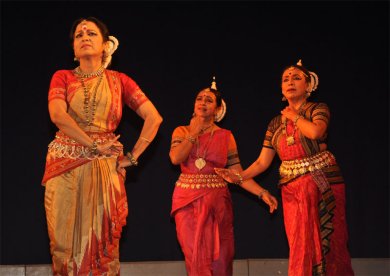
|   |

|   |
Tributes to Guru Kelubabu - Vijay Shanker e-mail: vijaydance@gmail.com May 29, 2014 To mark the tenth death anniversary of renowned Odissi exponent and mentor Guru Kelucharan Mohapatra, popularly called Kelubabu, Bhavan's Cultural Centre presented an Odissi dance program at their open air amphitheatre known as Pranganga in Andheri, Mumbai on 18th April. Today, Odissi is one of the most popular classical dance styles known for its elegance, beauty and technique. Guru Kelubabu along with star disciples like Sanjukta Panigrahi, Protima Bedi and others were instrumental in placing Odissi dance on the international platform. The legacy moves forward with his talented son Ratikant Mohapatra.  Three Mumbai based accomplished Odissi exponents Debi Basu, Jhelum Paranjape and Daksha Mashruwala along with their disciples performed select items from the Odissi repertoire which included Jayadeva’s ashtapadis. The program commenced with the percussion music ensemble led by Rohan Dahale and Ramprasad with instruments like mardala and tabla. After the brief percussion musical extravaganza that gave a rhythmic enhancement to the program, the Odissi performance commenced with the invocation to Lord Jagannath, "Shruta Kamala" performed by Anu Narayan, Sangeeta Rajan and others who are the disciples of Debi Basu. The typical lyrical and elegant movements pertaining to pure dance and the technique of Odissi were perceived in the Simhendra Pallavi, also noteworthy for the musical melody and harmony. The secular number "Vaishnava Janatho" propagating the message of "sarva dharma samanvayam" wherein the dancers draw your attention to the three main religions, namely Hinduism, Christianity and Islam, was performed well by the disciples of Daksha Mashruwala. Guru Kelubabu was not only the most popular Odissi mentor but was also well-known for the subtle, lyrical and artistic interpretation of Jayadeva’s ashtapadis which in detail describes the intimate relationship of Radha, Krishna and the gopis. The varied layers of emotions pertaining to love, jealousy, anguish, pain, suffering and union are vividly described in the ashtapadis. Normally it is the heroine, who suffers from the pangs of separation and is waiting anxiously to meet her Lord but in the ashtapadi "Dheera sameere Yamuna teere" it is Lord Krishna who is waiting anxiously on the banks of the river Yamuna to meet Radha. In fact, Radha's friend tells her, “Don’t waste your time, go and meet Krishna as he is waiting for you.” This number was performed well by Debi Basu, who is one of the senior most exponents in Mumbai. While Daksha performed “Kisalaya sayana,” Jhelum performed "Pasyati dishi dishi" in which in the sancharis, Radha sees Krishna in the tree, in the garlands and everywhere and runs forward to embrace him and realizes it is only an illusion. Choreographed by Kelubabu, it was performed extremely well with touching bhava by Jhelum Paranjape. A unique tribute to a great master. Vijay Shankar is a Kuchipudi and Kathakali exponent, teacher, bilingual journalist, arts critic and actor. |